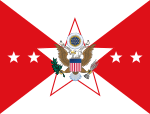Wade H. Haislip
| Wade H. Haislip | |
|---|---|
 | |
| Nickname(s) | "Ham" |
| Born |
July 9, 1889 Woodstock, Virginia, United States |
| Died |
December 23, 1971 (aged 82) Walter Reed Army Medical Center, Washington, D.C., United States |
| Buried at | Arlington National Cemetery |
| Allegiance |
|
| Service/branch |
|
| Years of service | 1912–1951 |
| Rank |
|
| Unit |
|
| Commands held |
85th Infantry Division XV Corps Seventh Army Vice Chief of Staff of the United States Army |
| Battles/wars |
Pancho Villa Expedition World War I World War II |
| Awards |
Distinguished Service Medal (4) Legion of Merit Bronze Star (2) |
| Other work | Governor, Soldiers Home |
General Wade Hampton Haislip (July 9, 1889 – December 23, 1971) was a senior United States Army officer who served in both World War I and World War II, where he led the XV Corps in the campaign in Western Europe from 1944 to 1945. He later became a four-star general, serving as Vice Chief of Staff of the United States Army (VCSA) from 1949 to 1951.
Military career
Haislip was born in Woodstock, Virginia on July 9, 1889, and moved at age 2 to Staunton, Virginia.[1] He was commissioned a second lieutenant of infantry upon graduating from the United States Military Academy at West Point in 1912.
Haislip served in Vera Cruz, Mexico in 1914 after the Tampico Affair. From 1917 to 1921, he served with the American Expeditionary Forces, first in World War I, then in the occupation of Germany. During his time overseas his assignments included being on the General Staff of V Corps; Division Machine Gun Officer for the 3rd Division, and General Staff, U.S. Forces in Germany. During World War I he participated in the Battle of Saint-Mihiel and the Meuse-Argonne Offensive. He returned to West point as an instructor from 1921 to 1923. He next attended a series of schools, beginning with the U.S. Army Infantry School from 1923 to 1924, then the Command and General Staff School from 1924 to 1925, and finally going back overseas to attend the French Ecole Superieure de Guerre from 1925 to 1927. He returned to the United States as Assistant executive in the Office of Assistant Secretary of War from 1928 to 1931, followed by the Army War College from 1931 to 1932, and an assignment as an instructor at the Command and General Staff School from 1932 to 1936.
Prior to World War II he held a series of staff assignments, including time in the Budget and Legislative Planning Branch of the War Department General Staff from 1938 to 1941, and Assistant Chief-of-Staff for personnel.
In World War II, he organized the 85th Infantry Division and served as commander from April 1942 to February 1943. He next took command of XV Corps and served with it through Normandy, France, Rhineland, and Central Europe campaigns. He became commander of Seventh United States Army, and was in that billet when World War II ended in August 1945.
Following the war he was on the Secretary of War's Personnel Board from September 1945 to April 1946, and a senior member of the Chief-of-Staff's Advisory Group from 1946 to 1948. Prior to his selection in 1949 as Vice Chief of Staff he was Deputy Chief-of-Staff for administration, 1948-49. He retired in 1951.
Post military career
After retiring from active duty in 1951, Haislip went on to become Governor of the Soldier's Home in Washington, D.C., a position he filled from 1951 to 1966.
Haislip died on December 23, 1971 at Walter Reed Army Medical Center after suffering a stroke, and was buried in Arlington National Cemetery. His wife, the former Alice Jennings Shepherd (1897–1987), whom he had married on July 14, 1932, was later buried beside him.
Trivia
Haislip is responsible for introducing Dwight D. Eisenhower to Mamie Doud. Eisenhower was a second lieutenant and Haislip a first lieutenant at Fort Sam Houston at the time. At Eisenhower's funeral, he served as a pall-bearer.[2]
Notes
References
| Military offices | ||
|---|---|---|
| Preceded by New post |
Commanding General 85th Infantry Division 1942–1943 |
Succeeded by John B. Coulter |
| Preceded by New post |
Commanding General XV Corps 1943–1945 |
Succeeded by Walter M. Robertson |
| Preceded by Alexander Patch |
Commanding General Seventh Army June 1945 – August 1945 |
Succeeded by Geoffrey Keyes |
| Preceded by J. Lawton Collins |
Vice Chief of Staff of the United States Army 1949–1951 |
Succeeded by John E. Hull |

